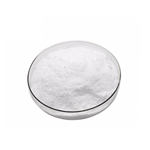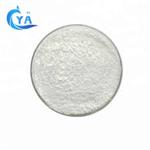Cinnamic acid: Toxicity, Pharmacokinetics and Application
Apr 14,2023
General description
Cinnamic acid is an unsaturated carboxylic acid, and it occurs naturally in a number of plants. It exists as both a cis and a trans isomer, although the latter ismore common. It is a key chemical found in plants such as Cinnamomum cassia (Chinese cinnamon) and Panax ginseng, fruits, whole grains, vegetables and honey. It is an unsaturated aromatic acid with a slight smell of cinnamon. It exists in the form of free or ester in balsam pear, cinnamon oil and coca leaf. It is often used as food additives such as preservatives or odorants.

Figure 1 Appearance of cinnamic acid.
Characteristics
Cinnamic acid is a White to Off-White clean powder with a melting point and boiling point of 133 ° C (lit.) and 300 ° C (lit.) respectively. Its density and refractive index are 1.2475 g/cm3 and 1.5049 (estimated) respectively. It is soluble in ethanol, ether, acetic acid, chloroform and acetone. Cinnamic acid has cis-trans isomers. Both positive and negative isomers have honey flower aroma and sweet and spicy taste.
Chemical synthesis
The cinnamic acid can be synthesized by single step according to the previous work [1]. The mixture of aryl halide (1 mmol), alkene (1.2 mmol), K3PO4 (2 mmol), CMC-PdII (0.9 mol % Pd), and aqueous 90% DMF (v/v%, 5 mL) were added into a flask and the mixture was stirred in a preheated oil bath at 110 °C for a specific time. The progress was monitored by TLC. Once completion of the reaction, the catalyst was filtered, washed with 95% ethanol (v/v%), and dried under vacuum for the next run. When a styrene was used as substrate, the filtrate was extracted by diethyl ether (3 × 5 mL), the organic layer was washed with brine (5 mL), separated, and dried over anhydrous Mg2SO4. The product was obtained after removing the ethereal solution under vacuum. The crude products were further purified by recrystallization with ethanol. When an acrylic acid was used as substrate, the filtrate was acidified with dilute HCl to precipitate the crude product, which was further purified by recrystallization with ethanol.
All of the products are known compounds and their melting point, 1H NMR, and IR spectra data were identical to that reported in literature. Entry: 14; yield: 68%; product: (E)-Cinnamic acid. mp (°C):134-135. 1H NMR (500 MHz, DMSO) δ: 12.41 (s, 1H, COOH), 7.74-7.67 (m, 2H, Ar-H), 7.60 (d, J = 16.0 Hz, 1H, CH=), 7.48-7.40 (m, 3H, Ar-H), 6.54 (d, J = 16.0 Hz, 1H, CH=); IR (KBr) v: 3026, 2592, 1681, 1629, 1494, 1449, 1421, 1285, 1222, 980, 847, 768 cm-1.
Application
There are many uses of cinnamic due to its physical and chemical characteristics. Cinnamic acid is a fragrance ingredient used in many fragrance compounds. It may be found in fragrances used in decorative cosmetics, fine fragrances, shampoos, toilet soaps and other toiletries as well as in non-cos- metic products such as household cleaners and deter- gents. Its use worldwide is in the region of 1–10 metric tonnes per annum [2]. Cinnamic acid is an important organic synthesis raw material, mainly used in the synthesis of methyl cinnamate, ethyl cinnamate, benzyl cinnamate, and widely used in the spice industry and pharmaceutical industry. It has been used as an insect repellent in medicine.
Toxicity
Ten rats per dose were dosed via gavage with 3.25, 3.75 and 5.0g/kg bodyweight. Observations for mortality and or systemic effects were made. At 5.0g/kg, 9/10 deaths were observed, at 3.75g/kg, 6/10 deaths were observed and at 3.25g/kg, 3/10 deaths were observed. The acute oral LD50 in rats was calculated to be 3.57g/kg [2]. Groups of white rats, white mice and guinea pigs were dosed orally with a 20–45% solution of cinnamic acid in sunflower oil. Three animals/sex/dose were tested for each species and they were observed over a 15-day period. The LD50 for all three species was reported to exceed 5.0g/kg/bodyweight (no further details were reported) [3].
Absorption
The absorption of radiolabelled cinnamic acid in acetone through excised human abdominal skin was measured by Bronaugh et al. [4] using an in vitro diffusion cell technique. Both occluded and non-occluded absorption was mea- sured. Sections of skin 350 lm thick were removed from the surface of full thickness skin. A flow-through cell was used; normal saline was pumped through the cells (skin surface area 0.64 cm2) at a rate of 5 ml/h and col- lected in scintillation vials. The receptor fluid was saline. Cinnamic acid in acetone was applied to the excised skin at a concentration of 4lg/cm2 and the surface of the skin was washed after 24 h. The study was continued un- til absorption was complete (48–72h). The tops of the diffusion cells were sealed with parafilm for experiments measuring occluded absorption. Absorbed radioactivity was determined by liquid scintillation counting. The amount of cinnamic acid absorbed through nonoccluded skin was 17.8 ± 4.9% of the dose and the amount absorbed through occluded skin was 60.8 ± 10.2%.
Pharmacokinetics
Twenty-three healthy volun- teers and 17 volunteers with hepatocellular disease were fasted. After a control specimen of blood was obtained, cinnamic acid was administered orally in gelatin cap- sules at a dose of 0.6g/30 pounds. Serum cinnamic acid levels were measured hourly over a 4-h period. The aver- age serum cinnamic acid levels in normal subjects ran- ged from 0.3 to 3.4 mg/100 ml; in patients with hepatocellular disease, the serum cinnamic acid level was elevated, ranging from 4.2–13.8 mg/100 ml [5].
References
[1]Xiao et al. Carboxymethylcellulose-Supported Palladium Nanoparticles Generated in Situ from Palladium(II) Carboxymethylcellulose: An Efficient and Reusable Catalyst for Suzuki-Miyaura and Mizoroki-Heck Reactions. Industrial & Engineering Chemistry Research, 2015, 54(3): 790-797.
[2]Letizia et al. Fragrance material review on cinnamic acid. Food and Chemical Toxicology. 2005, 43 (6): 925-943.
[3]Zaitsev et al. Some data on the toxic properties of phenylethanol and cinnamic alcohols. Voprosy Pitaniya 1974, 6, 48–53.
[4]Bronaugh et al. Comparison of percutaneous absorption of fragrances by humans and monkeys. Food and Chemical Toxicology. 1985, 23, 111–114.
[5]Saltzman et al. Cinnamic acid as a test substance in the evaluation of liver function. Journal of Clinical Investigation 1953, 32, 711–719.
- Related articles
- Related Qustion
- Cinnamic Acid: Properties, Composition, and Applications in Modern Chemistry May 14, 2024
Cinnamic acid (C9H8O2) is characterized by a crystalline structure and typically appears as white to light yellow crystals.
- Cinnamic Acid: Dietary Sources, Mechanisms of Action and New Formulation Jan 9, 2024
Cinnamic acid in plant-based foods stimulates insulin secretion, but its limited bioavailability led to new formulations like nanoparticles for improved effectiveness against chronic diseases.
Di-tert-butyl dicarbonate is referred to as Boc anhydride, which can be used in the protection and deprotection of amines.....
Apr 14,2023Organic reagentsCinnamic acid
621-82-9You may like
- Cinnamic acid
-

- $13.00 / 1kg
- 2024-05-30
- CAS:621-82-9
- Min. Order: 1kg
- Purity: 99%
- Supply Ability: 300tons
- Cinnamic acid
-

- $0.00 / 1kg
- 2024-05-27
- CAS:621-82-9
- Min. Order: 1kg
- Purity: 0.99
- Supply Ability: 500000kg
- trans-Cinnamic acid
-

- $0.00 / 1kg
- 2024-05-15
- CAS:621-82-9
- Min. Order: 1kg
- Purity: 99%
- Supply Ability: 1 tons




